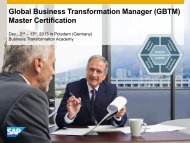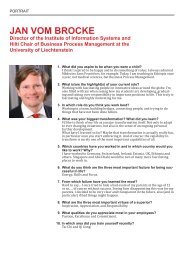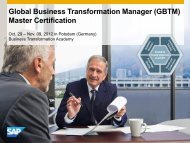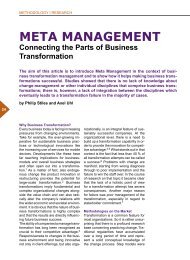Digital Enterprise Transformation - 360° Journal
Digital Enterprise Transformation - 360° Journal
Digital Enterprise Transformation - 360° Journal
- No tags were found...
You also want an ePaper? Increase the reach of your titles
YUMPU automatically turns print PDFs into web optimized ePapers that Google loves.
METHODOLOGY | RESEARCHDeveloping a strategy provides answers to theDeveloping following questions: a strategy provides answers to the following questions:Industry Drivers- What • What are are current and future industry and and technological technological drivers? drivers?- How • How do do they they affect the existing business business model? model?Business ModelOrganization &Business ProcessesTechnology- What • What is the is the vision for the digital enterprise? enterprise?- How • How should it it position itself?• What does the future IT strategy look like, and what are the action plans?- What does the future IT strategy look like, and what are the action plans?- What• Whatarearethetheorganizationalorganizational consequences?consequences?- What • What does does the the project portfolio look look like? like?- What • What does the cost cost / benefit / benefit analysis analysis and the and financial financial plan look plan like? look like?- What • What are are the the technological requirements for the for future the business future business model? model?- What • What are are the the weaknesses and opportunities of the of existing the existing technology technology infrastructure?infrastructure?- What • What adjustments need to to be be made? made?© 2012 SAP AG. All rights reserved. 1vival. Figure 1 lists the questions that astrategy in general should provide answersfor (Hammer 1988, 59-60). Thisalso applies to IT strategy planning. Itspurpose is to provide the applications aswell as the information and communicationstructures required to support thecompany’s business model in the bestpossible way. For this reason, the tasksof strategic IT management include enterprisearchitecture planning (containingapplication and data integration),long-term change management, projectportfolio planning, and implementationplanning.Figure 2 presents three possible approachesfor aligning IT and businessstrategies. As mentioned above, theclassic procedure for developing an ITstrategy is to derive it from the corporatestrategy and business organization.This is also referred to as “IT followsbusiness”. However, if the technologicaldrivers are used as enablers to definea new business model and/or to enternew markets, the approach is called“IT as strategic enabler”. The businessstrategy and the business organizationcan then be derived from the IT strategyin an iterative process. An example ofthis is the e-Commerce company Amazonwhich was founded and organized in1994 based on the strategy of using theinternet as their distribution channel forbooks. “Innovate the IT” is the third approach.It usually involves replacing anexisting technology with a more modernone that is extra powerful in the senseof improved integration, higher performance,or greater security. One exampleis the replacement of host-basedlegacy systems in the banking sectorwith modern client/server architectures.Although the “Innovate the IT” approachgenerally has no or little impact on thebusiness model, it must be coordinatedFig. 1: Developinga strategyprovides answersto the essentialquestions (source:Adapted fromHammer 1988,59-60)33Abstract<strong>Enterprise</strong>s are strongly influenced by new trends like social media, cloud computing, mobile connectivity,and big data. Thus, beside business and IT issues, IT governance has to cope with theneeds and requirements of stakeholders like customers and employees in order to establish competitiveadvantages through information technology. This article introduces a <strong>Digital</strong> CapabilityFramework to assess the potential for improvement and the readiness for transforming into a <strong>Digital</strong><strong>Enterprise</strong> based on such trends, and it shows how to make most use of those opportunities.













